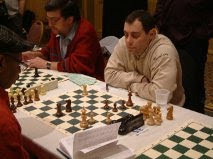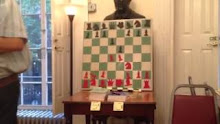After reading Monokroussos's latest entry in the Philidor Counter Gambit controversy, I am reminded that Bobby Fischer once described Paul Morphy as "probably the most accurate player" in chess history. Morphy championed the PCG in several important games, most notably the consultation game Staunton & Owen-Morphy & Barnes, London 1858. Morphy played with pinpoint accuracy in these games. Until now, my analysis in the PCG debate has been less than 100% accurate.
For instance, take the position after the opening moves 1.e4 e5 2.Nf3 d6 3.d4 f5 4.Nc3 fxe4 5.Nxe4 d5 6.Neg5 exd4 7.Bb5+ c6 8.Bd3 Bb4+ 9.Bd2 Bxd2+ 10.Qxd2 Nf6 11.O-O-O O-O 12.Nxd4.
Obviously White is threatening to win the exchange by landing a knight on e6. But, given Black's lagging development, it is inaccurate to move an already developed piece by 12...Re8?!. This explains why the defense is always a day late and a dollar short after 13.Rhe1 h6 14.Rxe8+ Qxe8 15.Re1, no matter where the black queen moves.
More to the point for Black is developing the queen on move 12, rather than moving the rook a second time. Two alternatives to 12...Re8?! that suggest themselves are the speculative 12...Qb6!? and the solid 12...Qd6.
The problem with 12...Qb6!? is what to do after 13.Qf4!.
Unappealing to me is a line like 13...Ne4 14.Qh4 Nxg5 15.Qxg5 Na6 16.Qh5! g6 17.Bxg6 Qc7 18.Bd3 Nc5 19.Rhe1 Qf4+ 20.Kb1 Nxd3 21.Rxd3 Bf5 22.Rg3+ Kh8 23.Qd1 Rae8 24.Nxf5 Rxe1 25.Qxe1 Rxf5 26.Qe6 Rf8 27.Rf3 Qb8 28.Rf7 Rxf7 29.Qxf7.
Instead of 13...Ne4, Black can try 13...c5. But I don't like the looks of 14.Nxh7! cxd4 15.Nxf8 Kxf8 16.h4 when White's threat of advancing the h-pawn to the sixth rank is too hot to handle.
Unless improvements for Black are found in these lines, I would steer clear of the risky 12...Qb6!? in favor of the more sensible 12...Qd6 13.Rhe1 g6.
One possible continuation, by no means forced, is 14.h4 Nh5 15.g3 Ng7 16.f4 h6 17.Ngf3 Bg4 18.Be2 Nd7 19.Ne5 Bxe2 20.Rxe2 Rae8 when Black is still in there pitching.
The other critical position in our debate occurs after 7.Nxd4 Qe7+ 8.Be2 h6 9.Ngf3 c6 10.O-O Qf6 11.Re1 Bb4 12.c3 Bd6 13.Ba6+ Kf7 14.Bd3 Ne7 15.c4.
Monokroussos has shown 15...Rf8?! to be imprecise after his ingenious 16.Rb1 a5 17.Bh7! which denies the g8 square to Black's king.
The precise rook move is 15...Rd8. Now, after 16.Rb1 a5, the move 17.Bh7?! lacks teeth because the f8 square is available to Black's king. In fact, the wandering bishop may be in danger of capture after 17...dxc4 18.Qe2 b5 19.Bd2 Nd5 20.a4 g6! 21.Bxh6 Bf4 22.Bxf4 Nxf4 23.Qe3 Kg7.
Rather than 17.Bh7?!, White should play 17.b3 Kg8 18.Bb2 Qf7 with a slight plus.




























